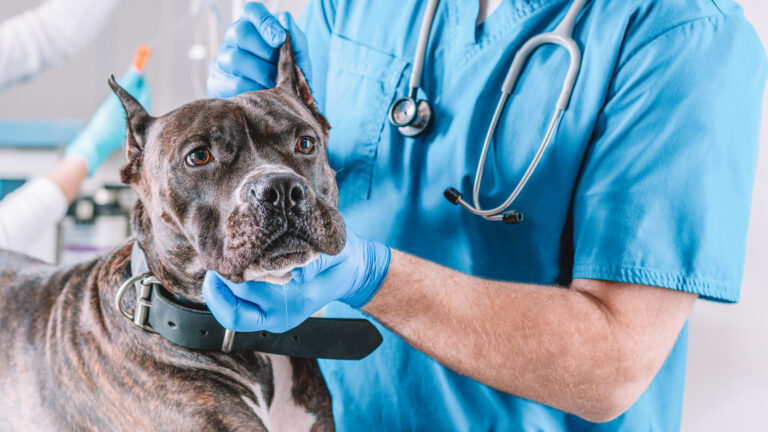If your dog has recently been diagnosed with liver disease, you likely have questions. What exactly is liver disease? What treatment options are available? What type of diet should I feed them?
While you should rely on your veterinarian to ultimately make a proper diagnosis and choose the most appropriate treatment for your dog, the following primer is designed to help you better understand this complex disease and what you can do to reduce the risks.
Defining liver disease
Because the liver plays key roles in almost every metabolic process—from assisting with digestion and storing vitamins and minerals, to metabolizing drugs and detoxifying—the diseases affecting it can vary widely. The term “liver disease” can actually refer to several different ailments impacting the liver and impairing its function, from infections to tumors to endocrine disorders. These are some of the most common diseases that impact the liver:
- Chronic canine hepatitis, the ongoing presence of inflammation of the liver.
- Copper storage hepatopathy, which occurs when the liver absorbs more copper than it needs, eventually resulting in liver toxicity.
- Liver cancers, such as primary hepatocellular carcinoma and hemangiosarcoma
- Liver infections, including canine infectious hepatitis and leptospirosis
- Liver shunts (the medical term is portosystemic shunts), which occur when the blood vessels don’t communicate properly with the liver, so blood from the gastrointestinal system flows through the body, bypassing the liver, causing a buildup of toxins
Causes and risk factors of liver disease
Depending on the specific type of liver disease a dog is diagnosed with, causes and risk factors vary. Some of these include the following:
Primary diseases
Endocrine disorders including thyroid disease and diabetes, and adrenal gland conditions like Cushing’s disease—in which the body produces too much of the hormone cortisol—can coincide with liver disease, says Jessica Romine, DVM, DACVIM, and a veterinarian at BluePearl Specialty and Emergency Pet Hospital in Southfield, Michigan. “These secondary liver issues are some of the most common reasons for liver values to be raised on bloodwork.”
Environmental toxins
Several toxins associated with liver failure are blue green algae, Xylitol (a sugar substitute), Amanita mushrooms, and Sago Palms. Commonly prescribed drugs can also impact the liver and cause liver issues.
Toxic agents can vary by region, says Dr. Romine, who is board-certified in veterinary internal medicine. “For example, in the South, dogs are more likely to have access to Sago palms, a decorative plant that causes acute liver failure if ingested.”
Infectious agents
These can be caused by viruses, such as adenovirus CAV-1, which results in infectious canine hepatitis; fungi, which causes coccidioidomycosis and histoplasmosis; or bacteria like Leptospira, responsible for leptospirosis.
A dog’s genes
Some dog breeds may be at greater risk of developing certain types of liver disease. For example, some breeds, like Doberman pinschers and Labrador retrievers are known to be at risk for copper storage hepatopathy. Labradors are also known to be more prone to autoimmune liver inflammation, says Dr. Romine.
Breeds like Yorkshire terriers and Maltese dogs are more prone to developing portosystemic shunts, as noted, a blood vessel anomaly that allows blood from the abdominal organs to flow to the heart, bypassing the liver. “These are congenital issues, but they aren’t always diagnosed until later in life. While these breeds are more commonly affected, they can occur in any breed.”
Other breeds, like golden retrievers—and generally, larger-breed dogs—are at a higher risk for cancers like hemangiosarcoma. “But again, we see liver cancers in all sizes and ages of dogs, and some like hepatocellular carcinoma are much less influenced by genetics,” says Dr. Romine.
Signs of liver disease
These can be subtle and easy to miss, especially with chronic conditions. “Because the liver is capable of some degree of regeneration, dogs often do not feel ill until very late in the course of disease,” says Dr. Romine. “Often, high liver values are found on blood work while the dog is still acting normally, or has only mild signs such as not wanting to eat dry dog food but still eagerly eating human food and treats.”
In general, some common symptoms of liver disease in dogs are
- weight loss
- sluggishness
- less interest in eating
- vomiting
- diarrhea
Symptoms can vary, however, depending on the specific disease. For example, when liver disease is the secondary disease—as in diabetes or Cushing’s disease—symptoms will be more associated with the primary disease, says Dr. Romine. “In these cases, dogs may develop a pot belly, lose hair, or develop a ravenous appetite and significantly increased thirst and urination.”
Dogs with liver cancer may exhibit similar signs, she says, and may also become weak from blood loss. “Dogs with acute toxicities usually rapidly become very ill with weakness, vomiting, diarrhea, and anorexia. Jaundice can occur with more severe liver dysfunction or blockage of the gallbladder, and leads to yellowing of the whites of the eyes, the gums, the thin skin on the belly and ears, and bright yellow urine.”
Diagnosis and treatment of canine liver disease
After giving your dog a complete examination, the veterinarian will often order blood tests to make a correct diagnosis. Urine tests may also be ordered to look for bilirubin (increased levels indicate liver failure), which Dr. Romine says can appear there before it does in the blood.
The veterinarian may also order additional tests. “Bile acids testing is often recommended if the liver values are high on blood work, if specific disorders like portosystemic shunts are suspected, or if there is a concern for liver function. From there, testing may be recommended to test for other hormonal or endocrine issues, look for infectious causes like leptospirosis,” explains Dr. Romine.
X-rays help assess the overall size of the liver and screen for large liver masses, while ultrasounds can evaluate the liver’s texture, identify cancers that are smaller or more distributed, and look for signs of gallbladder infection or blockage. Ultimately, for many liver issues, liver biopsies via surgery or laparoscopy are needed to make a definitive diagnosis, says Dr. Romine.
The type of treatment depends on the type of liver disease your dog has been diagnosed with. For example, a dog with liver cancer or one who’s born with a liver shunt may need surgery. Supportive care, which is used to slow the disease’s progression and give the liver time to heal, is also an important part of treatment. A protocol can include drugs like antibiotics, antioxidant supplementation, and diet restrictions.
Reducing risks of liver disease
There are some things you can do to reduce your dogs’ risk of developing certain types of liver disease.
- Prevent exposure to toxins like Amanita mushrooms, Sago palms, blue green algae, and xylitol.
- Keep current with vaccinations. “Have your dog vaccinated for adenovirus and leptospirosis (adenovirus is commonly administered as part of the DAPP vaccine),” says Dr. Romine.
- Keep regular veterinary appointments. “The key is that many of these diseases can be identified and reversed if caught early, before major damage and scarring of the liver has occurred, but if testing like ultrasound and liver biopsies are delayed too long, the diseases can be too far progressed to fix, and cancers with a great prognosis if removed (like hepatocellular carcinoma) can be too big to remove surgically,” says Dr. Romine.
Nutrition for dogs with liver disease
Veterinarians say that with the exception of severe liver disease, most diagnosed dogs can continue to enjoy a healthy, complete and balanced diet. The diet your veterinarian prescribes will depend on the type of liver disease your dog has been diagnosed with.
While it’s commonly assumed that diets to support liver function should be generally lower in protein, a low-protein diet is typically only appropriate in the case of advanced stages of liver disease. The best diet to support liver function is a complete and balanced diet with high-quality ingredients. Recipes should also be easy to digest to reduce nausea and other symptoms and ideally have a high caloric density to reduce the amount of food passing through the system (and therefore needing processing by the liver). This kind of diet will support a healthy appetite, so they don’t stop eating altogether.
The following are some dietary options your veterinarian may consider. It’s important not to attempt to make changes without a veterinarian’s guidance.
Protein restriction
Protein restriction is usually reserved only for dogs showing signs of hepatic encephalopathy (HE), according to the World Small Animal Veterinary Association (WSAVA). HE is a potentially fatal neurological condition that results from advanced liver disease; portosystemic shunts are a leading cause of HE.
WSAVA says reducing the amount of protein for all dogs with liver disease can lead to protein malnutrition.
Prescription diets
Prescription diets are available for dogs with certain types of liver disease, including portosystemic shunts, copper hepatopathy, and hepatic encephalopathy, but these are not appropriate for healthy dogs, or dogs who only have blood work changes and not those specific liver diseases.
Lower copper diets
Dogs with copper storage disease require a lower-copper diet, says Dr. Romine. According to WSAVA, there is evidence that most commercial dog foods may contain too much chelated copper for some dogs, which can lead to the accumulation of copper. Be sure to feed a diet that sticks to the minimum requirements for copper (like the fresh recipes from The Farmer’s Dog).
Nutritional supplements
Your veterinarian may recommend certain supplements to assist with your dog’s supportive care. For example, given that chronic liver disease produces free radicals, supplements like S-adenosylmethionine (SAMe) and milk thistle can be given for their antioxidant properties.
Supplements, as well as dietary changes, should only be made under the recommendation and guidance of your veterinarian.
Depending on the type of liver disease, prognosis can vary, but veterinarians say that many diagnosed dogs can live normal lives. Early intervention is critical, however. Keeping your dog’s regular veterinary appointments, learning to spot the signs of liver disease, and following preventive measures can go a long way in keeping your canine family member’s liver healthy.
Pet health is an important topic. That’s why The Farmer’s Dog editorial team carefully vets and reviews every piece of content we publish. We deliver evidence-based advice and medically reviewed facts that focus on pet nutrition, health, and well-being. The mission of this site is to help people provide the best care possible for their dogs by publishing only trustworthy, accurate, and timely health information from a group of passionate experts.







